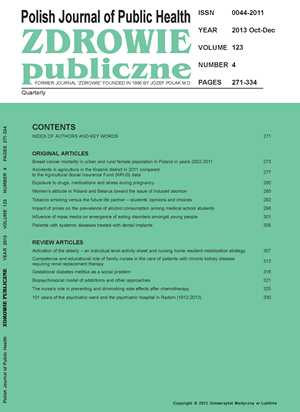Impact of prices on the prevalence of alcohol consumption among medical school students
DOI:
https://doi.org/10.12923/j.0044-2011/123-4/a.06Keywords:
alcohol, price , students, medical school, alcohol policiesAbstract
Introduction. Alcohol is a major risk factor of diseases, especially cardiovascular diseases, and mortality. There are more and more proposals to reduce alcohol consumption, including the controlling the price of alcohol.
Aim. The aim of this study was to assess the prevalence of alcohol use among students of the Medical University of Lublin, with a particular focus on the impact of alcohol prices on the size of its consumption.
Material and methods. A survey among 168 students from various fields of study was conducted in 2012. The research tool was a questionnaire containing 43 questions.
Results. Alcohol was consumed by 92.86% of respondents (95.24% men and 92.06% women). Most of them (48.72%) were drinking less than once a week, 31.41% – one or two times per week and 19.87% – more than twice a week. Nearly two times more likely to drink are men. Since the start of their higher education, 36.49% of students increased alcohol intake, for 43.24% consumption remained unchanged, and decreased for 20.27%. The most common alcohol of choice is beer (to 56.41%), followed by wine (20.51%) and vodka (16.67%). Men spend more on alcohol per week compared to women. Students who positively evaluate their health spend less on alcohol than those who rate their health as average or poor. However, the level of wealth does not affect the profile of drinking alcohol. Introduction of a minimum price for alcohol is advocated by 27.00%, against 45.00%, no clear opinion is presented by 28.00% of respondents.
Conclusions. Student community is aware of the problems associated with alcohol and proposes several ways to minimize abuse. However, there is no clear support for any of these ideas. Price does not play the most important role in choosing the type of alcohol, but with the increase by 50% or more, we can expect a significant reduction in consumption. Low pro-bability of large markup, which would significantly reduce alcohol consumption, forces to look for other ways of fighting this addiction.
References
1. WHO, 2009 Global health risks. Mortality and burden of disease attri-butable to selected major risks.
2. www.who.int/mediacentre/factsheets/fs349/en/index.html
3. European Commission. First progress report on the implementation of the EU alcohol strategy. Annex 1: Development of alcohol policy and action in EU Member States 2006-2009. Brussels: European Commission, Directorate-General for Health and Consumers; 2009,
4. WHO, 2012 Alcohol in European Union. Consumption, harm and policy approaches.
5. Żuralska R, Dziedziczko A, Marcinowski A. Alkohol a młodzież szkolna. Zdr Publ. 2006;116(1):12-4.
6. Huk-Wieliczuk E, Litwiniuk A. Picie alkoholu przez uczniów wiejskich w wieku 15-17 lat. Zdr Publ. 2004;114(3):312-4.
7. Gerstenkorn A, Suwała M. Picie alkoholu przez studentów medycyny. Zdr Publ. 2004;114(1):59-62.
8. Wójtowicz-Chomicz K, Kowal M, Wojtowicz M, Borzęcki A. Evaluation of anti-healthy behavior among students od Medical University In Lublin. Probl Hig Epidemiol. 2007;88(1):108-11.
9. Cooke E, Hastings G, Wheeler C, et al. Marketing of Alcohol to Young People: A Comparison of the UK and Poland. Eur Addict Res. 2004;10:1-7.


